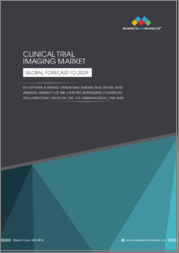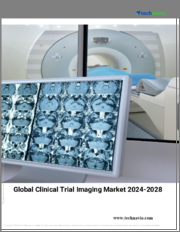
|
시장보고서
상품코드
1532127
세계의 임상시험 이미징 시장 평가 : 서비스별, 모달리티별, 치료 영역별, 최종 사용자별, 지역별 기회 및 예측(2017-2031년)Clinical Trial Imaging Market Assessment, By Services, By Modality, By Therapeutic Area, By End-user, By Region, Opportunities and Forecast, 2017-2031F |
||||||
세계의 임상시험 이미징(Clinical Trial Imaging) 시장 규모는 2023년 13억 5,000만 달러에서 2031년 25억 달러에 이를 것으로 예측되며, 예측기간인 2024-2031년 CAGR 8.01%로 추이하며 성장 할 것으로 예상됩니다. 시장은 연구개발비 증가, 의료영상기업 확대, 임상연구기관(CRO) 증가 등 요인에 의해 견인되고 있습니다.
의료 이미지는 첨단 생명 과학 장비 및 키트 개발에 필수적입니다. 의료 영상 시장은 끊임없이 변화하고 있음에도 불구하고 생명 공학 및 제약 산업은 일관된 성장을 보이고 있습니다. 이는 의료기기의 임상시험을 촉진하는 혁신적인 이미징기술의 채택을 포함한 의료영상기업에 대한 투자 증가나 M&A에 의한 점이 큽니다. 기술의 진보로 임상시험의 이미지 데이터 수집, 해석, 제출이 크게 개선되었습니다. 기술 기반 이미징, 특히 이미지 분석 소프트웨어는 통합, 데이터 품질, 유연성, 컴플라이언스 등 임상 연구에 여러 가지 이점을 제공합니다. 예를 들어, 이미지 분석 소프트웨어는 촬영 시점을 평가하여 독자의 유도 및 감독에 사용할 수 있습니다. 또한, 처리 능력의 향상과 함께 이미징 기술의 이용이 증가하고 있으며, 임상시험에서 이미징의 이용이 가속될 것으로 예측됩니다. Quantitative Imaging Biomarkers Alliance(QIBA) 프로그램은 임상시험에서 과학적이고 정확하게 정의된 결과를 달성하기 위해 표준화된 기법과 이미징 프로세스를 개발했습니다.
2024년 5월 Parexel International Corporation(Calyx Medical Imaging)은 기존 프론트라인 치료에 실패한 전이성 흑색종 환자에 대한 세포 치료인 Iovance Biotherapeutic의 Amtagvi(lifileucel)의 매우 중요한 2단계 임상시험에 참여 를 발표했습니다. Calyx는 임상시험의 영상 진단 컴포넌트의 개발과 구현을 지원했습니다. 따라서 60개의 조사 시설이 영상 평가 방법에 따라 환자의 CT, 자기 공명 영상(MRI), 양전자 방사선 단층 촬영(PET), 피부 촬영 사진을 수집할 수 있었습니다.
연구개발비 증가
연구개발(R&D) 비용 증가는 임상시험 이미징 시장 성장의 주요 촉진요인입니다. 제약기업과 생명공학기업은 신약이나 신치료법을 요구하여 연구개발에 대한 투자를 확대하고 있으며 효과적인 임상시험시스템이 필요합니다. 이러한 기업들이 연구개발에 더 많은 자금을 투입함에 따라 신약의 유효성과 안전성을 판단하는데 있어서 이미징이 필수적이기 때문에 임상시험 이미징 서비스의 요구가 높아지고 있습니다. Qureight Ltd.는 임상시험 이미징을 통해 신약 개발의 이미징을 촉진하기 위해 850만 달러에 해당하는 시리즈 A 라운드의 완료를 발표했습니다. Qureight Ltd.의 디지털 인프라 하우스는 철저한 검사를 위해 다양한 의료 데이터를 관리합니다. Qureight Ltd.는 NHS England와의 데이터 계약을 통해 독점 의료 액세스를 제공하며 CT 스캔, 바이오마커 및 기타 임상시험 엔드포인트를 병원 및 임상연구기관(CRO)에서 실시간으로 직접 수집 수 있습니다.
의료 영상 기업의 확대가 시장 성장을 가속
의료 영상 기업은 진단 능력 향상과 기술 진보에 대한 수요 증가로 성장을 계속하고 있습니다. 주목할만한 발전으로 다양한 형태와 이미징 위치에서 POC(Point of Care) 진단을 제공하는 포켓 크기의 초음파 장비와 같은 휴대용 핸드 헬드 이미징 기술의 제조가 있습니다. 또한 이미징 시스템에 AI와 머신러닝을 통합하면 진단 정확도와 워크플로우 효율성이 향상됩니다. Siemens Healthineers 및 GE Healthcare와 같은 기업은 휴대용 MRI 시스템과 자동 엑스레이 스캐너와 같은 획기적인 기술을 도입하여 접근성을 높이고 업무를 가속화하고 있습니다. 2023년 12월, GE Healthcare Technologies Inc.는 RADI 2023에서 AI 기반의 새로운 MRI 기계 출시를 발표했습니다.
세계의 임상시험 이미징(Clinical Trial Imaging) 시장에 대해 조사 분석했으며, 시장 규모 및 예측/시장 역학/주요 기업 정세 및 전망 등 정보를 제공합니다.
목차
제1장 프로젝트 범위 및 정의
제2장 조사 방법
제3장 주요 요약
제4장 세계의 임상시험 이미징 시장 전망(2017-2031년)
- 시장 규모 분석 및 예측
- 금액
- 시장 점유율 분석 및 예측
- 서비스별
- 모달리티별
- 치료 영역별
- 최종 사용자별
- 지역별
- 시장 점유율 분석 : 기업별(금액 기준, 상위 5개사 및 기타-2023년)
- 시장 맵 분석(2023년)
- 서비스별
- 모달리티별
- 치료 영역별
- 최종 사용자별
- 지역별
제5장 북미의 임상시험 이미징 시장 전망(2017-2031년)
- 시장 규모 분석 및 예측
- 금액
- 시장 점유율 분석 및 예측
- 서비스별
- 모달리티별
- 치료 영역별
- 최종 사용자별
- 점유율 : 국가별
- 시장 평가 : 국가별
- 미국의 임상시험 이미징 시장 전망(2017-2031년)
- 캐나다
- 멕시코
제6장 유럽의 임상시험 이미징 시장 전망(2017-2031년)
- 독일
- 프랑스
- 이탈리아
- 영국
- 러시아
- 네덜란드
- 스페인
- 폴란드
제7장 아시아 태평양의 임상시험 이미징 시장 전망(2017-2031년)
- 인도
- 중국
- 일본
- 호주
- 베트남
- 한국
- 인도네시아
- 필리핀
제8장 남미의 임상시험 이미징 시장 전망(2017-2031년)
- 브라질
- 아르헨티나
제9장 중동 및 아프리카의 임상시험 이미징 시장 전망(2017-2031년)
- 사우디아라비아
- 아랍에미리트(UAE)
- 남아프리카공화국
- 이스라엘
제10장 수요 공급 분석
제11장 수출입 분석
제12장 밸류체인 분석
제13장 Porter's Five Forces 분석
제14장 PESTLE 분석
제15장 가격 분석
제16장 시장 역학
- 시장 성장 촉진요인
- 시장 과제
제17장 시장 동향 및 발전
제18장 규제 프레임워크 및 혁신
- 임상시험
- 규제 당국의 승인
제19장 특허 정세
제20장 사례 연구
제21장 경쟁 구도
- 시장 리더 상위 5개사의 경쟁 매트릭스
- 상위 5개사의 SWOT 분석
- 주요 기업 상위 10개 회사의 상황
- Koninklijke Philips NV
- Navitas Clinical Research Inc.
- Parexel International Corporation
- Medpace Holdings Inc
- Radiant Sage LLC
- Clario Inc
- Icon Plc
- Ixico Plc
- ProScan Imaging LLC
- Resonance Health Ltd.
제22장 전략적 권장사항
제23장 당사에 대하여, 면책사항
LYJGlobal clinical trial imaging market is projected to witness a CAGR of 8.01% during the forecast period 2024-2031, growing from USD 1.35 billion in 2023 to USD 2.50 billion in 2031. The global clinical trial imaging market is being driven by factors such as growing expenditures in research and development, expansion of medical imaging companies, and increasing number of Clinical Research Organizations (CROs).
Medical imaging is essential for the development of advanced life science devices and kits. Despite the ever-changing nature of the medical imaging market, the biotechnology and pharmaceutical industries are experiencing consistent growth. This is mostly owing to increased investment in medical imaging firms, and mergers and acquisitions including the adoption of innovative imaging technology to facilitate clinical trials for medical devices. Technological advancements are significantly improving the collection, interpretation, and submission of clinical trial imaging data. Technology-based imaging, particularly image analysis software, brings several advantages to clinical research, including uniformity, data quality, flexibility, and compliance. For instance, image analysis software may be used to guide and supervise a reader by evaluating imaging points in time. Furthermore, the increasing use of imaging technologies, along with improved processing power, is projected to accelerate the use of imaging in clinical trials. The Quantitative Imaging Biomarkers Alliance (QIBA) program has developed standardized methodologies and imaging processes to achieve scientifically and precisely defined outcomes in clinical studies.
In May 2024, Parexel International Corporation (Calyx Medical Imaging) announced its involvement in the pivotal phase II clinical study of Iovance Biotherapeutic's Amtagvi (lifileucel), a cell therapy for people with metastatic melanoma who have failed existing front-line treatments. Calyx helped develop and implement the imaging components of trials. Thus, 60 investigation sites were able to collect patient CT, magnetic resonance imaging (MRI), positron emission tomography (PET), and skin photography pictures in accordance with the image review methodology.
Growing Expenditures in Research and Development
Rising research and development (R&D) expenditures are a major driver for the growth of the clinical trial imaging market. Pharmaceutical and biotechnology businesses are growing their investment in R&D in search of new drugs and cures, necessitating effective clinical trial systems. As these corporations devote more money to R&D, the need for clinical trial imaging services increases, as imaging is critical in determining the efficacy and safety of new medicines. Qureight Ltd. announced their Series A round completion worth USD 8.5 million for expediting drug development imaging through clinical trial imaging. Qureight Ltd.'s digital infrastructure houses curates a variety of medical data for thorough examination. Qureight Ltd. has unique healthcare access through NHS England data contracts, allowing it to collect CT scans, biomarkers, and other trial endpoints directly from hospitals or clinical research organizations (CROs) in real time.
Expansion of Medical Imaging Companies to Drive Market Growth
Medical imaging firms are growing due to increased demand for enhanced diagnostic capabilities and technical advancements. Notable developments include manufacturing of portable and handheld imaging technologies, such as pocket-sized ultrasound devices, which provide point-of-care diagnostics in different modalities and imaging positions. Additionally, incorporating artificial intelligence (AI) and machine learning into imaging systems improves diagnosis accuracy and workflow efficiency. Companies such as Siemens Healthineers and GE Healthcare are introducing revolutionary technologies such as portable MRI systems and automated x-ray scanners to increase accessibility and accelerate operations. In December 2023, GE Healthcare Technologies Inc. announced the launch of its new AI-based MRI machine at the Radiological Society of America Scientific Sessions and Annual Meetings (RSNA 2023).
CT Scans Dominate the Global Clinical Trial Imaging Market Share
Computed tomography (CT) devices have been frequently used in clinical trial imaging due to their ability to produce detailed images of internal organs. CT scans use X-rays and computer processing to generate comprehensive cross-sectional digital images of the body, allowing clinicians and researchers to detect and quantify changes in tissues and organs over time. CT scans are secure and convenient for patients and researchers. Furthermore, researchers prefer CT scans as they can generate large volumes of data in a short period of time, which is useful for collecting and analyzing data from several patients to detect trends and patterns. The fast-track coronary artery bypass grafting (CABG) study, was led by the University's CORRIB research center for advanced imaging and core lab. Heart surgeons planned and performed CABG using non-invasive cardiac-CT scan images with the help of HeartFlow's AI-powered blood flow analysis, the doctors were able to identify problems in patient's coronary arteries.
Oncology to Account Dominant Market Share
Oncology is the leading segment amongst different types of therapeutic areas. The factors such as high prevalence of cancer cases and constant need for new and innovative therapies to treat various cancer types are expected to fuel market growth. Oncology trials often involve complex imaging requirements due to the need to assess tumor size, treatment responses, and disease progression. Various imaging modalities, such as CT scans, MRI, PET scans, and others, are used to evaluate the effectiveness of cancer treatments. This complexity results in a larger share of the market being dedicated to oncology.
Future Market Scenario (2024-2031F)
Future clinical trials will be increasingly employed with multi-modal imaging techniques, combining various imaging modalities such as MRI, CT, and PET. This approach will offer a comprehensive view of anatomical and physiological processes, facilitating better correlation of findings and improving the overall understanding of pathologies.
The use of wearable devices will provide continuous, real-time health data from trial participants. The technology aims to enhance patient engagement and reduce the burden of participation by allowing remote monitoring, thus making clinical trials more accessible and patient centric.
AI is set to revolutionize clinical trial imaging by enhancing diagnostic accuracy and efficiency. AI algorithms will improve image quality, reduce scan times, and automate tasks such as image interpretation and report generation. It will allow radiologists to focus on more complex cases while ensuring timely and precise disease detection.
The trend towards decentralized clinical trials will continue, leveraging technology to conduct trials remotely. It will involve partnerships with end-to-end solution providers who can manage imaging logistics, data harmonization, and secure analysis, ultimately enhancing trial efficiency and participant experience.
Key Players Landscape and Outlook
Several medical imaging companies and clinical research organizations are growing in the global clinical trial imaging market by planning and adopting new strategies. New agreements, contracts, mergers and acquisitions, investments, and partnerships, along with major strategic initiatives through which companies are increasing their market shares.
Pie Medical Imaging Inc., a global leader in cardiac imaging, announced in June 2024 its enrollment in FASTIII, a multi-center randomized clinical trial. The trial is investigating the use of angiography-based vessel fractional flow reserve (CAAS vFFR) in patients undergoing coronary revascularization procedures. The vFFR can determine whether a coronary artery narrowing is functionally substantial and requires revascularization.
Table of Contents
1. Project Scope and Definitions
2. Research Methodology
3. Executive Summary
4. Global Clinical Trial Imaging Market Outlook, 2017-2031F
- 4.1. Market Size Analysis & Forecast
- 4.1.1. By Value
- 4.2. Market Share Analysis & Forecast
- 4.2.1. By Services
- 4.2.1.1. Clinical Trial Design and Consultation Services
- 4.2.1.2. Reading and Analytical Services
- 4.2.1.3. Operational Imaging Services
- 4.2.1.4. System and Technology Support Services
- 4.2.1.5. Project and Data Management
- 4.2.2. By Modality
- 4.2.2.1. CT Scan
- 4.2.2.2. MRI
- 4.2.2.3. X-Ray
- 4.2.2.4. Ultrasound
- 4.2.2.5. PET Scan
- 4.2.2.6. Echocardiogram (ECHO)
- 4.2.2.7. Optical Coherence Tomography (OCT)
- 4.2.2.8. Others
- 4.2.3. By Therapeutic Area
- 4.2.3.1. Oncology
- 4.2.3.2. Infectious Diseases
- 4.2.3.3. Neurology
- 4.2.3.4. Cardiovascular Diseases
- 4.2.3.5. Endocrinology
- 4.2.3.6. Others
- 4.2.4. By End-user
- 4.2.4.1. Pharmaceutical and Biotechnology Companies
- 4.2.4.2. Medical Device Manufacturers
- 4.2.4.3. Contract Research Organizations
- 4.2.4.4. Academic and Government Research Organizations
- 4.2.5. By Region
- 4.2.5.1. North America
- 4.2.5.2. Europe
- 4.2.5.3. Asia-Pacific
- 4.2.5.4. South America
- 4.2.5.5. Middle East and Africa
- 4.2.6. By Company Market Share Analysis (Top 5 Companies and Others - By Value, 2023)
- 4.2.1. By Services
- 4.3. Market Map Analysis, 2023
- 4.3.1. By Services
- 4.3.2. By Modality
- 4.3.3. By Therapeutic Area
- 4.3.4. By End-user
- 4.3.5. By Region
5. North America Clinical Trial Imaging Market Outlook, 2017-2031F*
- 5.1. Market Size Analysis & Forecast
- 5.1.1. By Value
- 5.2. Market Share Analysis & Forecast
- 5.2.1. By Services
- 5.2.1.1. Clinical Trial Design and Consultation Services
- 5.2.1.2. Reading and Analytical Services
- 5.2.1.3. Operational Imaging Services
- 5.2.1.4. System and Technology Support Services
- 5.2.1.5. Project and Data Management
- 5.2.2. By Modality
- 5.2.2.1. CT Scan
- 5.2.2.2. MRI
- 5.2.2.3. X-Ray
- 5.2.2.4. Ultrasound
- 5.2.2.5. PET Scan
- 5.2.2.6. Echocardiogram (ECHO)
- 5.2.2.7. Optical Coherence Tomography (OCT)
- 5.2.2.8. Others
- 5.2.3. By Therapeutic Area
- 5.2.3.1. Oncology
- 5.2.3.2. Infectious Diseases
- 5.2.3.3. Neurology
- 5.2.3.4. Cardiovascular Diseases
- 5.2.3.5. Endocrinology
- 5.2.3.6. Others
- 5.2.4. By End-user
- 5.2.4.1. Pharmaceutical and Biotechnology Companies
- 5.2.4.2. Medical Device Manufacturers
- 5.2.4.3. Contract Research Organizations
- 5.2.4.4. Academic and Government Research Institutes
- 5.2.5. By Country Share
- 5.2.5.1. United States
- 5.2.5.2. Canada
- 5.2.5.3. Mexico
- 5.2.1. By Services
- 5.3. Country Market Assessment
- 5.3.1. United States Clinical Trial Imaging Market Outlook, 2017-2031F*
- 5.3.1.1. Market Size Analysis & Forecast
- 5.3.1.1.1. By Value
- 5.3.1.2. Market Share Analysis & Forecast
- 5.3.1.2.1. By Services
- 5.3.1.2.1.1. Clinical Trial Design and Consultation Services
- 5.3.1.2.1.2. Reading and Analytical Services
- 5.3.1.2.1.3. Operational Imaging Services
- 5.3.1.2.1.4. System and Technology Support Services
- 5.3.1.2.1.5. Project and Data Management
- 5.3.1.2.2. By Modality
- 5.3.1.2.2.1. CT Scan
- 5.3.1.2.2.2. MRI
- 5.3.1.2.2.3. X-Ray
- 5.3.1.2.2.4. Ultrasound
- 5.3.1.2.2.5. PET Scan
- 5.3.1.2.2.6. Echocardiogram (ECHO)
- 5.3.1.2.2.7. Optical Coherence Tomography (OCT)
- 5.3.1.2.2.8. Others
- 5.3.1.2.3. By Therapeutic Area
- 5.3.1.2.3.1. Oncology
- 5.3.1.2.3.2. Infectious Diseases
- 5.3.1.2.3.3. Neurology
- 5.3.1.2.3.4. Cardiovascular Diseases
- 5.3.1.2.3.5. Endocrinology
- 5.3.1.2.3.6. Others
- 5.3.1.2.4. By End-user
- 5.3.1.2.4.1. Pharmaceutical and Biotechnology Companies
- 5.3.1.2.4.2. Medical Device Manufacturers
- 5.3.1.2.4.3. Contract Research Organizations
- 5.3.1.2.4.4. Academic and Government Research Institutes
- 5.3.1.2.1. By Services
- 5.3.1.1. Market Size Analysis & Forecast
- 5.3.2. Canada
- 5.3.3. Mexico
- 5.3.1. United States Clinical Trial Imaging Market Outlook, 2017-2031F*
All segments will be provided for all regions and countries covered
6. Europe Clinical Trial Imaging Market Outlook, 2017-2031F
- 6.1. Germany
- 6.2. France
- 6.3. Italy
- 6.4. United Kingdom
- 6.5. Russia
- 6.6. Netherlands
- 6.7. Spain
- 6.8. Poland
7. Asia-Pacific Clinical Trial Imaging Market Outlook, 2017-2031F
- 7.1. India
- 7.2. China
- 7.3. Japan
- 7.4. Australia
- 7.5. Vietnam
- 7.6. South Korea
- 7.7. Indonesia
- 7.8. Philippines
8. South America Clinical Trial Imaging Market Outlook, 2017-2031F
- 8.1. Brazil
- 8.2. Argentina
9. Middle East and Africa Clinical Trial Imaging Market Outlook, 2017-2031F
- 9.1. Saudi Arabia
- 9.2. UAE
- 9.3. South Africa
- 9.4. Israel
10. Demand Supply Analysis
11. Import and Export Analysis
12. Value Chain Analysis
13. Porter's Five Forces Analysis
14. PESTLE Analysis
15. Pricing Analysis
16. Market Dynamics
- 16.1. Market Drivers
- 16.2. Market Challenges
17. Market Trends and Developments
18. Regulatory Framework and Innovation
- 18.1. Clinical Trials
- 18.2. Regulatory Approvals
19. Patent Landscape
20. Case Studies
21. Competitive Landscape
- 21.1. Competition Matrix of Top 5 Market Leaders
- 21.2. SWOT Analysis for Top 5 Players
- 21.3. Key Players Landscape for Top 10 Market Players
- 21.3.1. Koninklijke Philips N.V.
- 21.3.1.1. Company Details
- 21.3.1.2. Key Management Personnel
- 21.3.1.3. Products and Services
- 21.3.1.4. Financials (As Reported)
- 21.3.1.5. Key Market Focus and Geographical Presence
- 21.3.1.6. Recent Developments/Collaborations/Partnerships/Mergers and Acquisition
- 21.3.2. Navitas Clinical Research Inc.
- 21.3.3. Parexel International Corporation
- 21.3.4. Medpace Holdings Inc
- 21.3.5. Radiant Sage LLC
- 21.3.6. Clario Inc
- 21.3.7. Icon Plc
- 21.3.8. Ixico Plc
- 21.3.9. ProScan Imaging LLC
- 21.3.10. Resonance Health Ltd.
- 21.3.1. Koninklijke Philips N.V.
Companies mentioned above DO NOT hold any order as per market share and can be changed as per information available during research work.



















